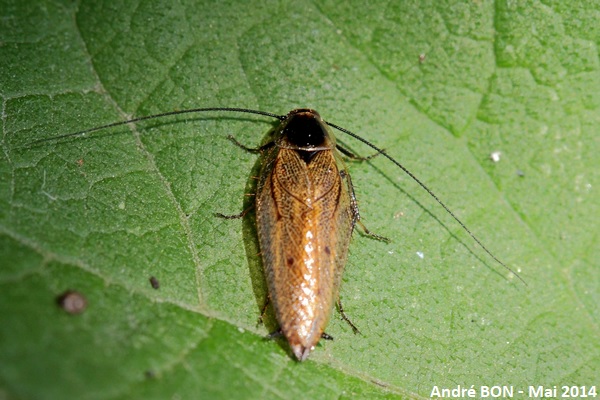
| Dusky Cockroach (Ectobius lapponicus (Linnaeus, 1758)) |

|
|
Scientific name: Ectobius lapponicus (Linnaeus, 1758) Common name: Dusky Cockroach French name: Blatte lapone, Cafard du nord. Order: Dictyoptera Family: Blattellidae Wingspan : 9 to 11 mm for males, 8 to 9.5 mm for females. Biotope: Deciduous forests, under the litter or on low growing plants. Geographic area: Europe but missing in the Iberian Peninsula, in southern Italy and in the United Kingdom. North of Asia but missing in China. Introduced to the eastern part of North America. Observation period : Adults : May to September. The adults die between September and October after females have laid their eggs in an ootheca. Juveniles hatch out at next spring and after 5 or 6 moults nymphs over winter again to become adults at next spring. This life cycle lasts two years. |
The Dusky Cockroach, like other members of the family, is an insect with a flat body, spiny legs and long antennae. It shows a rather wide black pronotum, with a rather translucent border on all sides. The central black mark is a uniform colour with blurred edges. It is a rounded shape without well marked angles. The fore wings or elytra, hardened and veined, are a pale brown colour with a few black spots. They cover all the body on males and taper at the rear. Females have shorter, wider and more rounded elytra which are only partially covering the abdomen. The edges of Ectobius sylvestris' pronotum are not translucent. The central patch shows very sharp edges. The back edge is almost straight and shows two well marked angles on each side. The black mark on Ectobius lucidus's pronotum is not as uniformly coloured as on the Dusky Cockroach. You can distinguish whitish Y-shaped mark on the central axis. The edges of the pronotum are also translucent. |
| [To know more about the Dusky Cockroach] [Top] |

|
The tapered shape and elytra covering the entire abdomen indicate one male. |